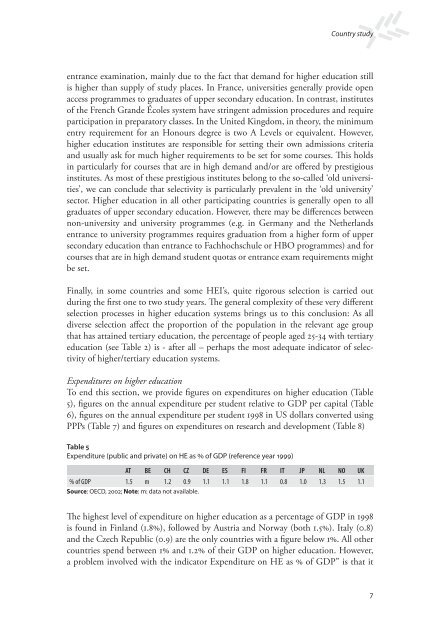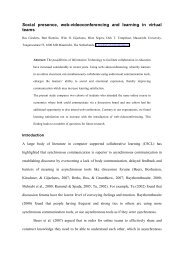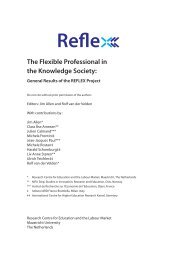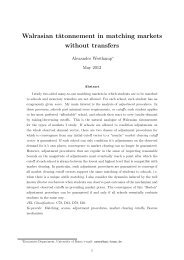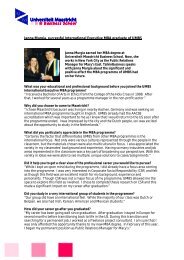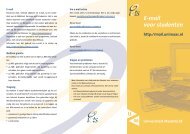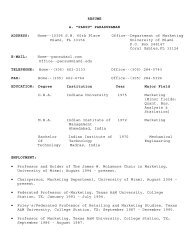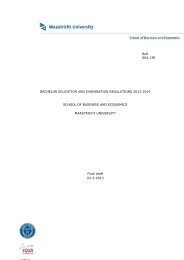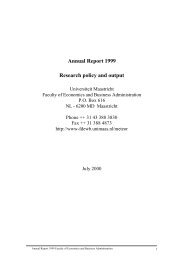Reflex Country study - School of Business and Economics ...
Reflex Country study - School of Business and Economics ...
Reflex Country study - School of Business and Economics ...
You also want an ePaper? Increase the reach of your titles
YUMPU automatically turns print PDFs into web optimized ePapers that Google loves.
<strong>Country</strong> <strong>study</strong><br />
entrance examination, mainly due to the fact that dem<strong>and</strong> for higher education still<br />
is higher than supply <strong>of</strong> <strong>study</strong> places. In France, universities generally provide open<br />
access programmes to graduates <strong>of</strong> upper secondary education. In contrast, institutes<br />
<strong>of</strong> the French Gr<strong>and</strong>e Écoles system have stringent admission procedures <strong>and</strong> require<br />
participation in preparatory classes. In the United Kingdom, in theory, the minimum<br />
entry requirement for an Honours degree is two A Levels or equivalent. However,<br />
higher education institutes are responsible for setting their own admissions criteria<br />
<strong>and</strong> usually ask for much higher requirements to be set for some courses. This holds<br />
in particularly for courses that are in high dem<strong>and</strong> <strong>and</strong>/or are <strong>of</strong>fered by prestigious<br />
institutes. As most <strong>of</strong> these prestigious institutes belong to the so-called ‘old universities’,<br />
we can conclude that selectivity is particularly prevalent in the ‘old university’<br />
sector. Higher education in all other participating countries is generally open to all<br />
graduates <strong>of</strong> upper secondary education. However, there may be differences between<br />
non-university <strong>and</strong> university programmes (e.g. in Germany <strong>and</strong> the Netherl<strong>and</strong>s<br />
entrance to university programmes requires graduation from a higher form <strong>of</strong> upper<br />
secondary education than entrance to Fachhochschule or HBO programmes) <strong>and</strong> for<br />
courses that are in high dem<strong>and</strong> student quotas or entrance exam requirements might<br />
be set.<br />
Finally, in some countries <strong>and</strong> some HEI’s, quite rigorous selection is carried out<br />
during the first one to two <strong>study</strong> years. The general complexity <strong>of</strong> these very different<br />
selection processes in higher education systems brings us to this conclusion: As all<br />
diverse selection affect the proportion <strong>of</strong> the population in the relevant age group<br />
that has attained tertiary education, the percentage <strong>of</strong> people aged 25-34 with tertiary<br />
education (see Table 2) is - after all – perhaps the most adequate indicator <strong>of</strong> selectivity<br />
<strong>of</strong> higher/tertiary education systems.<br />
Expenditures on higher education<br />
To end this section, we provide figures on expenditures on higher education (Table<br />
5), figures on the annual expenditure per student relative to GDP per capital (Table<br />
6), figures on the annual expenditure per student 998 in US dollars converted using<br />
PPPs (Table 7) <strong>and</strong> figures on expenditures on research <strong>and</strong> development (Table 8)<br />
Table 5<br />
Expenditure (public <strong>and</strong> private) on HE as % <strong>of</strong> GDP (reference year 1999)<br />
AT BE CH CZ DE ES FI FR IT JP NL NO UK<br />
% <strong>of</strong> GDP 1.5 m 1.2 0.9 1.1 1.1 1.8 1.1 0.8 1.0 1.3 1.5 1.1<br />
Source: OECD, 2002; Note: m: data not available.<br />
The highest level <strong>of</strong> expenditure on higher education as a percentage <strong>of</strong> GDP in 998<br />
is found in Finl<strong>and</strong> ( .8%), followed by Austria <strong>and</strong> Norway (both .5%). Italy (0.8)<br />
<strong>and</strong> the Czech Republic (0.9) are the only countries with a figure below %. All other<br />
countries spend between % <strong>and</strong> .2% <strong>of</strong> their GDP on higher education. However,<br />
a problem involved with the indicator Expenditure on HE as % <strong>of</strong> GDP” is that it


